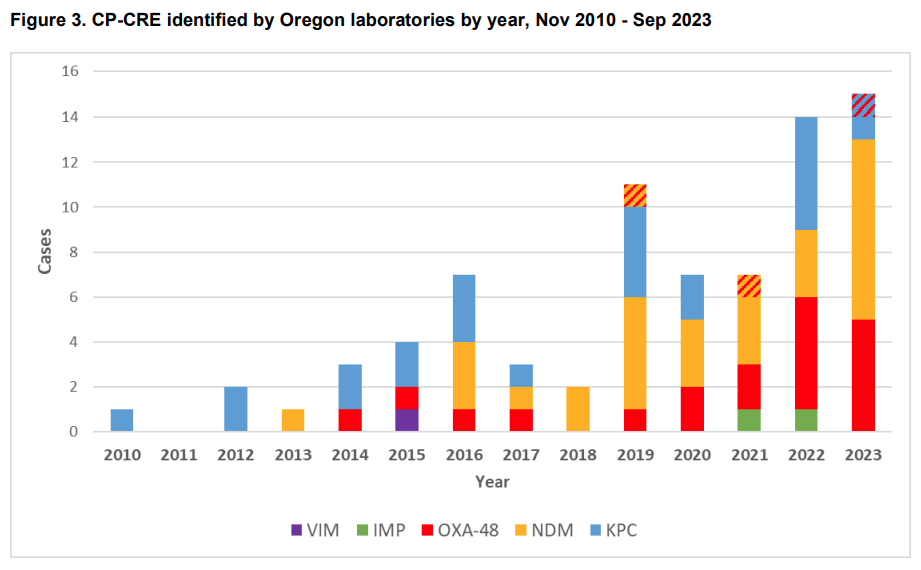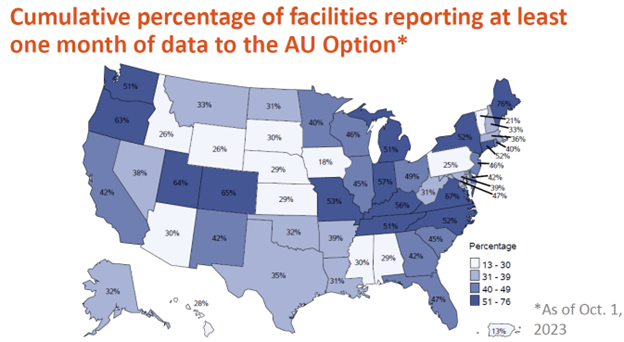|
|
Join us in observing U.S. Antibiotic Awareness Week (USAAW) Nov. 18-24 as we recognize the importance of appropriate antibiotic and antifungal use, improving health equity and addressing the threat of antimicrobial resistance across the One Health spectrum.
 In this season of gratitude, we extend a heartfelt thanks to our incredible partners and dedicated healthcare workers throughout Oregon. Your commitment to infection prevention and antimicrobial stewardship lights the path toward a healthier future for all.
Wishing you a holiday filled with joy and well-deserved rest.
|
|
|
When antibiotics or antifungals are used—in people, animals or plants—they can contribute to antimicrobial resistance (AR). Antimicrobial resistance happens when germs, like bacteria and fungi, develop the ability to defeat the drugs designed to kill them.
Antimicrobial resistance is one of the most urgent threats to public health worldwide. The inability to treat resistant infections results in increased illness and deaths. It can also make routine medical procedures much riskier.
Drug-resistant infections already cost too many lives. In the U.S., more than 2.8 million antimicrobial-resistant infections occur each year, with more than 35,000 deaths resulting from these infections. In 2019, nearly 5 million deaths worldwide were associated with bacterial antimicrobial resistance.

The Importance of Appropriate Antibiotic and Antifungal Use
Antibiotics continue to save countless lives and are critical tools for treating common and serious infections. Health care providers in doctors’ offices, hospitals, long-term care facilities, and all health care settings should be vigilant in their efforts to ensure that antibiotics are used only when necessary and appropriate. That means prescribing the right drug at the right dose at the right time, and for the right duration.
In U.S. doctors’ offices and emergency departments, an estimated 28% of antibiotic courses prescribed each year are unnecessary. Inappropriate and unnecessary antibiotic use not only drives the emergence of resistant bacteria, it also jeopardizes patient safety. Like any medication, antibiotics carry risks. While they are critical for treating a wide range of conditions—from strep throat to bacterial pneumonia to sepsis—these drugs can have significant side effects. Antibiotics can also kill off “good” bacteria in the body, which enables previously latent “bad” bacteria to multiply and increases a patient’s chances of developing secondary illnesses such as a Clostridioides difficile (C. diff) infection that can result in life-threatening diarrhea and colitis.
A new antimicrobial can take 10-15 years to develop and cost more than $1 billion, and the research and development pipeline for new antimicrobials is insufficient to tackle the challenge. Successfully addressing the increasing emergence and spread of antibiotic resistance requires that we practice careful stewardship of the antibiotics that we already have.
Improving the use of antibiotics and antifungals helps keeps us healthy now, helps fight antimicrobial resistance, and ensures these life-saving drugs will be available for future generations.
|

Health Equity
Health inequities can result from less- than-optimal antibiotic or antifungal prescribing practices. These inequities can impact health outcomes, resulting in an increase in drug-related adverse events or increased antimicrobial resistance. Disparities related to antimicrobial resistance are well documented. They can be affected by socioeconomic factors such as household income, type of health insurance, access to health care and education level.
Health equity is an Oregon Health Authority core value. OHA is committed to eliminating health inequities by 2030. OHA’s Healthcare-Associated Infections (HAI) Program continues to work with health care partners to identify inequities in antimicrobial prescribing practices and the occurrence of antimicrobial resistance across Oregon.
Preventing infections from happening in the first place is one of the best ways to improve antibiotic and antifungal use and protect populations who are disproportionately affected by antimicrobial resistance. Oregon Project Firstline is addressing training gaps for frontline health care workers from diverse educational and training backgrounds.
|

One Health
One Heath is an approach that recognizes that human health is closely connected to the health of animals, plants and our shared environment. Antimicrobial-resistant germs can quickly spread across communities, the food supply, health care facilities and around the world.
USAAW is closely aligned with World Antimicrobial Resistance Awareness Week priorities. The World Health Organization recognizes antimicrobial resistance as one of the biggest threats to global health, food security and development today. The challenges of misuse and overuse of antimicrobials in humans, animals and plants are complex and multifaceted and a One Health response is needed to save lives and preserve antimicrobial effectiveness.
|
|
|
- Oregon has implemented new reporting requirements to better track antimicrobial resistance. These include requirements for reporting Candida auris, carbapenem-resistant Acinetobacter, and organisms identified as carbapenem-producing organisms by clinical laboratories. In addition to these, OHA is interested in any pan-resistant organism, and health care professionals are asked to report them as "uncommon illnesses of potential public health significance" (OAR 333-018-0015).
- According to OHA’s Healthcare Worker Influenza Vaccination Dashboard, 64% of the state’s eligible health care workers from reporting facility types were vaccinated against the flu during the 2022-2023 flu season. This is similar to the 2021-2022 flu season rate of 63% and is well below the goal of 90%. Resuming progress in vaccinating health care workers is a priority to prevent the spread of influenza, which is expected to circulate in the community at pre-pandemic levels. See “Stewardship Snippet” below for more information about the role of vaccination in preventing antimicrobial resistance.
- Antimicrobial resistance is on the rise! The updated quarterly CRE report shows OXA-48 and NDM make up the largest proportion of carbapenemase-producing, carbapenem-resistant Enterobacterales (CP-CRE) cases in Oregon, with an uptick in all carbapenemase-producing organism cases in 2022 and 2023.

-
New Hemodialysis Staff Education Course: CDC has released a new continuing education course for dialysis technicians, nurses and other outpatient hemodialysis providers to help combat infections and antimicrobial resistance. This interactive online course, Infection Prevention in Outpatient Hemodialysis Settings, reviews infection risks and infection prevention and control recommendations for outpatient hemodialysis settings. It also provides an overview of tools and resources to help prevent infections and keep patients on dialysis safe. Free continuing education (CME, CNE, CEU, and CPH) is available. We encourage you to share this course widely. You can help improve patient safety!
- Effective January 2024, the College of American Pathologists (CAP) will require clinical laboratories performing antimicrobial susceptibility testing (AST) to use breakpoints currently recognized by Clinical and Laboratory Standards Institute (CLSI) or U.S. Food and Drug Administration (FDA).
-
CDC Training on Antibiotic Stewardship - Earn free continuing education credits learning about antibiotic resistance and strategies to combat antibiotic resistance. Available CE: CME, PA, CNE, CEU, CPH, CHES, MCHES, CPE
- As of Oct. 1, 2023, 63% of Oregon facilities have reported at least one month of antibiotic use (AU) data. All hospitals are required by Centers for Medicare and Medicaid Services (CMS) to report antibiotic use and resistance data to the NHSN AUR module starting in 2024.
  |
Infectious Insights
You can do harm by prescribing antibiotics when they are not needed. Remind your patients that antibiotics are not needed to treat most infections, particularly those caused by viruses (for example COVID-19). Talk to patients and their families about harms from antibiotics, such as allergic reactions, C. difficile and antimicrobial-resistant infections.
  |
- In a review of the published literature examining the association between health equity markers and drivers of antibiotic prescribing, patterns of prescribing disparities by race and ethnicity, geographical residence, socioeconomic status, and differential clinician treatment reflect similar disparities to those documented in the health care access, diabetes care and medication prescribing, and pain management literature. (08/23)
- Diagnostic stewardship refers to the appropriate use of laboratory testing to guide patient management, including treatment, to optimize clinical outcomes and limit the spread of antimicrobial resistance. Diagnostic stewardship decreases unnecessary antibiotic use in a way that is different from and complementary to antibiotic stewardship. (8/23)
|
|
-
U.S. Antibiotics Awareness Week (Nov.18-24) raises awareness of the threat of antibiotic resistance and the importance of appropriate antibiotic use.
- November is also diff Awareness Month, to raise awareness about this deadly threat and save lives. Clostridioides difficile (C. diff) is a germ that causes severe diarrhea, which can be life-threatening. C. diff can affect anyone and is usually associated with recent antibiotic use. CDC estimates that C. diff causes almost half a million infections in the United States each year. Learn how to optimize antibiotic therapy to minimize the risk of C. diff infection.
-
#GoPurpleforUSAAW
This year, across the nation, everyone is invited to "go purple" to raise awareness and serve as a reminder that the overuse and misuse of antibiotics can contribute to antibiotic resistance.
Individuals, organizations, and communities can show support by wearing purple, and be sure to tag your photos!
#AntimicrobialResistance #USAAW23 #PurpleForAR
- Salem and Woodburn will recognize US Antibiotic Awareness Week by lighting landmarks in purple.
 |
Salem’s Union Street Railroad Pedestrian Bridge (Nov. 18-24)
Salem’s Gerry Frank Rotary Amphitheater (Nov. 18)
- The Woodburn Interstate-5 Overpass Bridge (Nov. 18-22)
|
|

Get to know the exceptional members of our OHA HAI team. This quarter, we introduce Liz Breitenstein.
Liz is our Antimicrobial Stewardship Pharmacist. She received her Bachelor of Science in Psychology from Western Oregon University and Doctor of Pharmacy from Pacific University. Liz worked as a community pharmacist for many years and came to OHA to support the COVID-19 response. In her role, Liz leads state antimicrobial stewardship efforts, and supports providers and facilities across a variety of health care settings in Oregon.
Looking to the future, Liz is excited to find ways to collaborate with community-based organizations and to continue to raise community and patient awareness about the importance of appropriate and safe antibiotic use.
Growing up on a small family farm in Independence, Oregon, Liz enjoys travelling, but she will never get tired of enjoying our beautiful state.
|
|
|
 Ensuring that you and your patients are up to date on vaccinations not only keeps the community healthy but can help slow the emergence and spread of antimicrobial resistance.
Vaccination can:
- Prevent bacterial infections that may require antibiotic treatment.
- Prevent infections with drug-resistant pathogens.
- Reduce community transmission of antimicrobial-resistant pathogens.
- Since Pneumococcal conjugate vaccine (PCV) introduction among U.S. children in 2000, the rates of antibiotic-resistant invasive pneumococcal infections caused by vaccine strains decreased by 97% among children younger than 5 and by more than 60% among adults.
- Prevent viral infections for which antibiotics may be inappropriately prescribed.
- Reduce incidence of secondary bacterial infections.
- Flu-like illness often leads to the inappropriate use of antibiotics. Influenza infection can increase the risk of secondary bacterial infections such as pneumonia and otitis media, which then require antibiotic treatment.
|
|
|
The emergence of treatment-resistant fungal infections, like Candida auris, that can spread readily in health care settings is raising many concerns among health professionals. The HAI Program is focused on preventing spread of C. auris in our health care settings.
Why are fungal infections so concerning?
Currently, only a small number of antifungal drug types exist, so resistance can severely limit treatment options. Some types of fungi, like Candida auris, can become resistant to all the antifungal drugs normally used to treat these infections.
What causes antifungal resistance?
Resistance can develop when fungi are exposed to antifungal drugs, especially if the drugs are used improperly (for example, when dosages are too low or when treatment courses are not long enough).
Fungal disease is also a major concern in agricultural crops. Use of fungicides in plant crops can also contribute to resistant disease in people. For example, when Aspergillus found in the environment is exposed to fungicides, which are similar to medical antifungal drugs, the Aspergillus can become resistant to the drugs used to treat infections in people.
What can health care providers do?
- Ensure good infection prevention and control practices, including proper hand hygiene and environmental disinfection protocols.
- Prescribe antifungal drugs with appropriate dose, duration, and indication.
-
Test for resistant fungi in patients who are not improving with first-line antifungal drugs.
- Stay aware of resistance patterns, including among fungi, in your facility and community.
Enjoy a dose of infectious humor with a HAI-larious joke that's sure to brighten your day! Have a great joke in mind? Send us your jokes and we’ll feature you in one of our upcoming newsletters.
Source: www.facebook.com/twisteddoodles
|
|

Sign up for our newsletter to receive regular updates, explore new resources added to our website, and reach out to us with any questions or ideas you'd like to see in future newsletters. Let us know!
-
Sign up for our newsletter.
-
Share your feedback/suggestions/topics for future newsletters.
- Visit our website.
|
|
|
|
Oregon Health Authority works to transform the health care system in Oregon by lowering and containing costs, improving quality and increasing access to care to improve the lifelong health of Oregonians. OHA is overseen by the nine-member citizen Oregon Health Policy Board working toward comprehensive health reform in our state.
The HAI program within the OHA Public Health Division is dedicated to preventing and containing healthcare-associated infections (HAIs) and addressing the growing challenge of antimicrobial resistance (AR). Through initiatives such as the Antimicrobial Resistance Laboratory Network (AR Lab Network) and the National Healthcare Safety Network (NHSN), we are bolstering our ability to detect and respond to antibiotic resistance while strengthening the nation's most widely used HAI tracking system. We also focus on antibiotic stewardship to improve the appropriate use of antibiotics, and we provide comprehensive infection prevention and control (IPC) education and training to equip the health care workforce with the necessary skills. Our team further offers IPC consultations to health care facilities throughout the state, providing expert guidance and support in implementing effective infection prevention strategies and responding to outbreaks. Together, we are committed to enhancing patient safety and reducing the impact of HAIs and antimicrobial resistance.
|
|
|
|
|